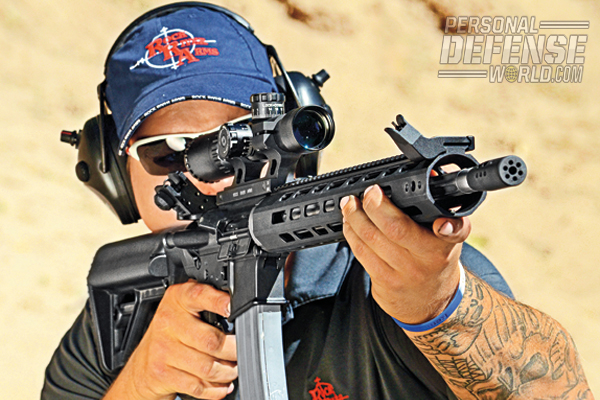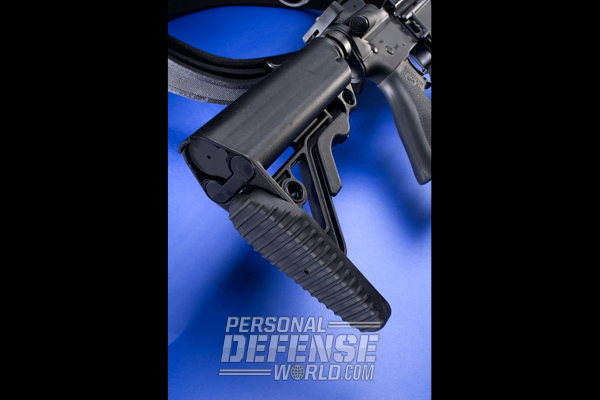The demand for AR-15 pattern rifles has exploded. Where years ago manufacturers generally made ARs for military, law enforcement, personal defense and some hunting applications, many now are making these guns for competition use–especially to satisfy the needs of those who participate in the growing sport of three-gun.
Three-gun matches are being held all around the country, and membership in clubs is growing. Competitors need not only handguns and shotguns, but rifles too, and the choice of many is an AR-style chambered in .223. Rock River Arms must have noticed because a recent addition to its catalog is the R3 Competition Rifle, which has many features that three-gun participants are going to love.
It’s basically an AR-15 that is capable of safely firing .223 and 5.56mm NATO cartridges because it has a .223 Wylde chamber. Many shooters are not familiar with the subtle differences between the 5.56mm NATO round–the cartridge fielded by the U.S. and NATO military–and the .223, which is the commercial version. Although the dimensions of the two cartridges are nearly identical, there are differences that could cause potential problems in the rifle.
Advertisement — Continue Reading Below
Describing the differences in detail and explaining why they matter is a subject that would take up all the space available for this article, so the short version is that the 5.56mm NATO cartridge is different and produces higher pressure and velocity than the commercial .223 cartridge. Because of that, the 5.56mm NATO chamber is slightly different, primarily in the leade (or freebore) area. It’s safe to shoot .223 ammunition in a 5.56mm NATO-chambered gun, but doing the reverse can be dangerous to the rifle and yourself. The .223 chamber has a shorter leade that promotes better accuracy but can also cause dangerously higher pressures when a 5.56mm NATO round is fired. To solve this problem, Rock River Arms uses a .223 Wylde chamber that allows the use of both cartridges and helps to preserve accuracy while not increasing pressures to dangerous levels in the rifle. Why would a manufacturer bother with this compromise chamber? Because today’s competitors seem to want everything, and the smart manufacturer will attempt to oblige.

Gun Details
Out in front of the chamber is the all-important barrel, in this case an 18-inch barrel made of 416 stainless steel with a 1-in-8-inch button rifled twist. That twist rate is another compromise designed to enhance accuracy and allow a wider range of bullets to be used. The twist rate is right in the middle between the two other popular AR twist rates of 1-in-7 and 1-in-9 inches. The faster the twist rate, the more capable it is of stabilizing longer, heavier bullets. A 1-in-8-inch twist rate should do fine with lighter, shorter bullets and still work for the heavier ones, too.
Advertisement — Continue Reading Below
“The handguard is a full 15 inches long so it extends almost to the end of the barrel. This allows a far-forward grip that is so popular among the competition crowd because it makes for fast transitions from target to target…”
The barrel is fluted for half its length to promote faster cooling while retaining the rigidity of a heavier barrel. This also enhances accuracy. Rock River goes the extra steps of cryogenically treating the barrel to relieve stress—an accuracy robbing characteristic—and then lapping each barrel before shipping to the customer. Besides helping with accuracy, the lapping makes it easier to clean the barrel.
At the end of the barrel, RRA installs a special muzzle brake (or compensator) that has two expansion chambers. The chamber closest to the muzzle is supposed to reduce the backwash of gas that follows the bullet out of the barrel and can interfere with the projectile’s trajectory, robbing it of its full accuracy potential. The other chamber directs gas upward and to the rear to reduce felt recoil. It’s really a fairly sophisticated compensator and helps to produce faster follow-up shots.
The barrel is free-floated, meaning that the barrel doesn’t touch the handguard. This is another accuracy enhancing feature, and because the handguard has many ventilation holes, plenty of air can get to the barrel to further aid in cooling it while keeping the shooter’s hands from getting burned. The handguard is a full 15 inches long so it extends almost to the end of the barrel. This allows a far-forward grip that is so popular among the competition crowd because it makes for fast transitions from target to target. Another nice feature of the handguard is that it has a Picatinny rail along the length of only the top surface and is smooth on the other seven sides. It’s much more comfortable to hold than a handguard that has Picatinny rails at 3, 6, 9 and 12 o’clock. However, for those who want to mount accessories like lights or lasers on the handguard, mounting points at 3, 6 and 9 o’clock are provided so that short rails can be added. Another mounting point is located on the bottom side about halfway back that could be used for a bipod or vertical foregrip. It’s shooter’s choice with this versatile Rock River Arms R3 Competition AR rifle.
Advertisement — Continue Reading Below

more comfortable hold.
The top of the upper receiver also has a Picatinny rail running its length so that the shooter can mount a sighting system. This could be a scope, red-dot sight or iron sights depending on preference. Both the upper and lower receivers are made of the standard material for ARs, 7075-T6 forged aluminum. They are then hardcoat anodized in black. The lower receiver controls are in the standard AR places and are standard AR fare except for the trigger and safety lever. On the test gun, the safety was a Star safety, which was very nice and, it could be argued, is easier to manipulate than a standard mil-spec, government-issue-style safety. An ambidextrous safety and magazine release are available as options. The magazine release worked as it was supposed to, and the magazine well is nicely beveled to encourage quick magazine changes. One 20-round AR magazine was provided.
The trigger is not mil-spec and is instead a Rock River Arms Two Stage Match Trigger that, after a small amount of take-up, broke at about 5 pounds. There was no discernible overtravel and the reset was positive. A chrome trigger is an option. This trigger, like many other of the gun’s features, is designed for accuracy. The trigger guard features an RRA Winter Guard that is bowed to allow room for a gloved finger.
Instead of a standard A2-style grip, Rock River Arms installs a rubberized Hogue grip with three finger grooves. Some shooters will love it and others won’t. But it is very slip-resistant and provides a good handle. As usual for most ARs, there is a dust cover and the nearly useless bolt forward assist.
Advertisement — Continue Reading Below

Inside the upper receiver resides the bolt carrier group, which has a manganese-phosphate finish and is chrome lined. The gas key is also chrome lined and the bolts holding it to the carrier are staked to prevent loosening. A chrome bolt carrier is an option. The bolt itself appeared to be standard for an AR and the vitally important extractor was equipped with a black spring insert to increase the gripping power on case rims for more reliable extraction.
Although the charging handle on the test gun was a standard AR government-issue style, RRA offers options. The owner can get a Badger Tactical Latch, an RRA Ambi, the Gas Buster Big Latch or the excellent Bravo Company Gunfighter with small, medium or large latch. Larger latches are good for speed, especially when clearing malfunctions.
Advertisement — Continue Reading Below
The receiver extension tube is of the larger diameter commercial variety, which is an important consideration if the owner ever wants to change the buttstock. A mil-spec buttstock fits the smaller diameter military tube and won’t fit the commercial tube.
The test gun’s castle (or extension) nut was not staked, but was probably secured with thread locker. Both work just fine, but if one ever wants to change the tubes out, the thread-locked nut is harder to remove.
A RRA Operator CAR Stock was provided that is adjustable to six lengths of pull. That’s a nice feature because the gun can be set up to comfortably fit different size shooters. The CAR stock also has a removable rubber buttpad to reduce the eyeball-dislodging recoil–that’s a joke–of the .223 round. The buttpad does, however, provide a slip-resistant surface so the gun won’t squirm around on the shooter’s shoulder. The buttpad also slides downward to reveal two compartments for the storage of batteries or other small parts. It’s a comfortable stock that has a wide surface for a good cheekweld. RRA also offers an A2-style fixed buttstock for those who prefer it.
Advertisement — Continue Reading Below
If you want to put a sling on the gun, the CAR stock has two quick-detach swivel sockets, but you will need to get a Picatinny rail for the handguard and an aftermarket swivel or socket.

Shooting Impressions
The Rock River Arms R3 Competition ran perfectly during the entire test period, with no malfunctions of any kind. A Leupold Mark 4 1.5-5x20mm MR/T was installed using a LaRue Tactical SPR-1.5 quick detachable mount. The mount is very important because it allows the optic to be removed and replaced without loss of zero.
Advertisement — Continue Reading Below
For tactical drills, an EOTech XPS3 holographic sight with a reticle consisting of a 1-MOA red dot surrounded by a 65-minute-of-angle circle was used. It was chosen because of its lightning fast sight acquisition features, which are critical for engagements at close range.
The gun proved to be accurate and printed groups of 0.50 to 1.75 inches at 100 yards depending on the ammunition selected. That should be plenty good for a 3-gun competition and is within the 0.75-MOA accuracy that RRA advertises. In tactical drills where transitions from target to target are so important, the muzzle brake (or compensator) helped to reduce muzzle rise and felt recoil to make follow-up shots faster. And the handguard kept hands from getting burned when lots of rounds were put through the barrel in a hurry.
Even though the Rock River Arms R3 Competition rifle is built for competition, it could be used for self-defense or hunting applications with the appropriate accessories. It’s a nice, versatile rifle that can fit a variety of needs.
Advertisement — Continue Reading Below







































